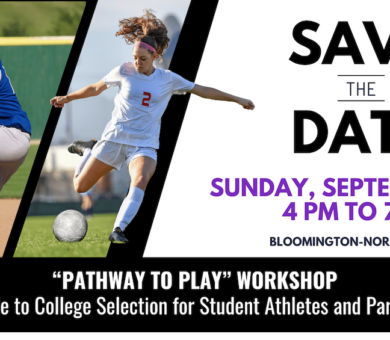Why Student Athletes Transfer From Their First College Choice
The college world of sports is changing daily. Today, there is more pressure placed on athletes, with more time spent practicing and playing their sport, more demands placed on them for speaking at public appearances, more time away from their families and social lives, and more time away from academics.
The recruiting process has also changed. There is very little time spent by college coaches or high school athletes to find a good fit for both parties. The process is rushed. Games are played by both sides in order to keep cards close to the vest. As you might imagine, honesty is not always what leads the process.
To sum up: the recruiting process is extremely challenging.
This is partially why the college transfer portal numbers are staggering. The NCAA established the transfer portal in 2018 because the numbers were already getting out of hand, and it was difficult to monitor the situation.
It doesn’t matter which sport, gender, or level. Athletes are transferring at higher and higher numbers every year.
Why is this happening, and what can be done to avoid becoming a number in that portal?
Reasons Athletes Transfer
There are many reasons athletes find that their first college choice was not the right one. Below is a short list:
- The college wasn’t the right fit.
- The college wasn’t what was expected.
- It was harder than expected.
- The coaches lied about the athlete’s role, playing time, the path toward graduation, etc.
- The academic side was too hard.
- They got injured.
- They didn’t like being far from home.
- A parent became ill.
- They became homesick.
- They had playing-time issues.
- They suffered abuse from a coach.
- The campus was unsafe.
- For mental health reasons.
- They didn’t get along with the team.
- Fifth-year eligibility was in issue.
These are just some of the many challenges that college student-athletes face.
All college students, regardless of being a student or a student-athlete, will face challenges that really push them out of their comfort zones. If the student can prepare for these challenges while still in high school, the adjustment to college life will be much easier.
Challenges will happen. Preparing for them is key to avoiding the long list of transfers.

Unforeseeable Challenges
First, let’s address the challenges that are out of the student athletes’ control. Some of these could be life events that take their twist and turns, usually unexpectedly.
- A family member becomes ill or passes.
- The athlete suffers a career-ending injury or illness.
- A tragedy occurs on campus.
- A pandemic strikes.
- College becomes too expensive.
Many times it is difficult to navigate these, but, when your child is seventeen- to twenty-two-years-old, these obstacles become even more difficult to address and handle.
For some, the only path forward is to leave college, quit altogether for the time being, or choose to go somewhere else.
In these cases, it is understandable that a college student would look for other options.
However, transferring to another college is not always the best solution.
Foreseeable Challenges
Different from the unforeseeable challenges are those that could have been overcome or avoided with the right preparation.
College Is Hard
The first thing to understand, as a family, is that college is really hard. The student is going to be told things they have never been told before, and they are going to be asked to do things they have never been asked to do before.
For example, they athlete may be told they are not good enough, not fast enough, and not strong enough and that they must sit the bench. This will probably be a new situation for them, as most college athletes who are going through the recruiting process have a lot of playing time in high school. Talking to them about these challenges will help your athlete enter college without a blindfold.
Your athlete will be told to jump higher, lift heavier weights, run faster, work out for longer hours, and train for most of the year. The games and competitions will be short in number compared to the hours college athlete train. This is a stark contrast to the high school years, where athletes play their season and then play a club or travel season.
They will be asked to give more time to their sport, but not to let academics fall as a result. They will be asked to sacrifice family, friends, and social life all in the name of their sport. Your child will miss things, and it will be hard.
They will be asked to work out mornings, afternoons, evenings, on weekends, and over holidays. Notice I said “work out,” not play in competitions, although that will happen, too (just much less than they would like).

It Begins With the Recruiting Process
To understand college athletics is to understand the recruiting process because that is where it all begins. If students make the recruiting process a priority, their success, productivity, and happiness in college will increase tremendously.
That doesn’t mean it is easy, but it does mean that they will be prepared and ready for what lies ahead, both in the recruiting process and when they transition into that first year of college.
The Approach
Student athletes should approach the college recruiting process with their mind and eyes wide open. They need to devise a college recruiting plan, so the process is working for them, and not against them. This takes work.
The Plan
Sit down and plan out what the process looks like for each person. The student athlete should really dive into who they are and what they want out of this journey. This takes practice and good guidance. This is why Find My Team gives each student athlete they work with the PCM6+ Assessment. It helps the student discover what they want in a college experience, and why.
The Choices
It’s important to highlight that every single decision made regarding the recruiting journey is critically important. Steps skipped or rushed through will have consequences later in the process and on into college.
The Research
Good research is usually the step that is the most rushed. It begins late, and it usually doesn’t finish. Decisions are made regardless. Again, the consequences will show up eventually.
The Decision
Many times the decision on where to attend college is finalized without the student understanding who they are and what they want, and everything from plan-to-decision is a blur.
Many athletes will feel good that the process is over, and not because they are confident that the right choice was made. The process is just finished, and the athlete doesn’t have to rush around and worry about it any longer. They find that relief and call it a day.
After a Commitment Is Made
After the commitment on where to attend college is made, the work is not over. The preparation continues, and it is just as important as when the athlete first began the process of going to college.
It takes time and energy to understand how to approach, and prepare for, college and what skills need to be developed in order to be successful. Some of that work can be learned through conversations with people. Some of that knowledge lies in dealing with how to handle failures and setbacks.
Living uncomfortably, and differently, from the first 17 years of life, this is what a college athlete will face.
College Coaches Are Human
College coaches have a huge job. First and foremost, they must win. Then they must also keep their student-athletes eligible and out of trouble, get people to attend their games, promote their programs, recruit new talent, and try to keep everyone on the team, on the staff, and all of boosters, administrators, and public happy. That’s a difficult task.
College coaches really don’t want their athletes to be in the transfer portal. They want them to be successful and happy in college. But coaches also want the hearts and souls of every athlete invested in their programs.
When problems arise, coaches want athletes to talk to them. They want to help athletes get issues worked out, but often, the communication does not happen and walls are built.
What happens next? The transfer portal.
To avoid the portal, the high school athlete must give the college recruiting process their undivided attention, work ethic, research, loyalty, and perseverance.
When that part of the journey is finished, they should apply the same due diligence to their transition into college. And when they become a college student-athlete, they must commit their entire selves to becoming the best they can be in, and away from, their sport.



